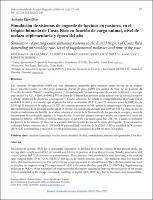| dc.contributor.author | Hernández Anguizola, José Daniel | |
| dc.contributor.author | Ramírez, Alberto | |
| dc.contributor.author | Pezo, Danilo | |
| dc.contributor.author | Villanueva, Cristóbal | |
| dc.contributor.author | Quiroz, Roberto | |
| dc.date.accessioned | 2024-10-02T16:28:30Z | |
| dc.date.available | 2024-10-02T16:28:30Z | |
| dc.date.issued | 2024 | |
| dc.identifier.uri | https://repositorio.catie.ac.cr/handle/11554/12679 | |
| dc.description.abstract | Silvopastoral systems (SSP) are a sustainable alternative to produce beef in the tropics. In the present study, the average daily weight gain (ADG) per animal was 0.64 kg in pastures of Urochloa brizantha 'Toledo', associated with Arachis pintoi and U. decumbens as a monoculture. These pastures have persisted for over ten years, with stocking rates ranging from 1.9 to 3.2 AU/ha (UA=400 kg) in 10-month rotation cycles. The paddocks had live fences of Gliricidia sepium and scattered trees of Erythrina poeppigiana and Cordia alliodora. The Life-Sim model was used to simulate the response using 25 comparisons of ADG with a mean absolute error (MAE) of 0.056 kg. Supplementing molasses at 18.32% of the potential DM intake provided the energy required to improve the utilization of the excess protein contained in the forage consumed, resulting in higher ADG (0.85 kg), but its inclusion was nonprofitable. Another scenario evaluated was the effect of fluctuating prices on the purchase and sale of fattened cattle throughout the year. The maximum gross margin per animal was for February (US$ 621), the minimum for March (US$ 445), and the annual mean was US$ 544. No difference among the starting months for fattening was detected when the prices for the last ten years were used. Other parameters evaluated were N consumption (139.66±3.88 g/animal/day); N use efficiency (25.60±0.58%); urinary N excretion (49.74±0.63 g/animal/day), fecal N (54.12±1.50 g/animal/day); and CH4 emissions (80.48±4.76 kg/year). | es_ES |
| dc.format.extent | 18 páginas | es_ES |
| dc.language.iso | es | es_ES |
| dc.relation.ispartof | Tropical Grasslands-Forrajes Tropicales | es_ES |
| dc.relation.uri | https://doi.org/10.17138/tgft(12)173-190 | es_ES |
| dc.subject | Sistemas silvopascícolas||silvopastoral systems||sistema silvopastoril||système sylvopastoral | es_ES |
| dc.subject | Ganado bovino||cattle||gado vacum||bovin | es_ES |
| dc.subject | Costa Rica||Costa Rica||Costa Rica||Costa Rica | es_ES |
| dc.subject | Carne | es_ES |
| dc.subject | Meat | es_ES |
| dc.subject | Engorde | es_ES |
| dc.subject | Fattening | es_ES |
| dc.subject | Trópico húmedo | es_ES |
| dc.subject | Humid tropics | es_ES |
| dc.subject | Análisis económico | es_ES |
| dc.subject | Economic analysis | es_ES |
| dc.subject | Arachis pintoi | es_ES |
| dc.subject | Simulación | es_ES |
| dc.subject | Simulation | es_ES |
| dc.subject | Urochloa | es_ES |
| dc.subject | Sistemas silvopastoriles | es_ES |
| dc.subject.other | Sede Central | es_ES |
| dc.title | Simulación de sistemas de engorde de bovinos en pastoreo en el trópico húmedo de Costa Rica en función de carga animal, nivel de maleza suplementaria y época del año | es_ES |
| dc.type | Artículo | es_ES |
| dc.creator.id | https://orcid.org/0000-0001-5360-7840 | es_ES |
| dc.creator.id | https://orcid.org/0000-0003-4218-7945 | es_ES |
| dc.creator.id | https://orcid.org/0000-0001-8401-2700 | es_ES |
| dc.identifier.status | openAccess | es_ES |
| dc.subject.sdg | ODS 12 - Producción y consumo responsables | es_ES |


